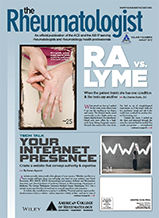RA vs. Lyme
 I am writing to comment on your interesting and useful article that appeared on the front page of the August issue of The Rheumatologist, “RA vs. Lyme,” by Charles Radis, DO.
I am writing to comment on your interesting and useful article that appeared on the front page of the August issue of The Rheumatologist, “RA vs. Lyme,” by Charles Radis, DO.
Arriving at a definite diagnosis of active RA early on is often not an easy task. The author of this article states that “rheumatoid physical findings typically are symmetric.” This is not always true. RA is a “bilateral” disease and frequently involves groups of symmetrical hand joints in a symmetrical fashion. This does not represent true symmetry. Review of diagnostic criteria from the past supports this statement. Another diagnostic feature that is occasionally helpful, although subtle, that may be noted during physical examination is the appearance of color change over or near the joint. Redness over involved joints is relatively infrequent. The joints in active inflammatory RA, however, may appear pale and sometimes “dingy” or “grimy,” giving the appearance of fingers or hands that look like in need of “washing.”
The author’s comments and discussion of Lyme disease were right on target in our experience. In fact, my colleagues and I have searched for Lyme arthritis (disease) in Kentucky ever since the disorder was first described and recognized, but have yet to find a documented case of Lyme disease that originated in the state. We have cases of Lyme where the diagnosis was made in Kentucky, but the onset of the disease occurred in locations such as New York, Connecticut and Maine, and so far no definite Lyme disease in Kentucky.
David H. Neustadt, MD, MACR, FACP
University of Louisville
Kentucky



